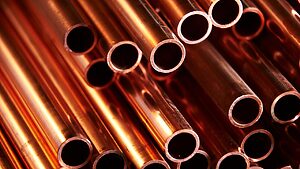The Hidden Secret to a Successful Heat Pump: Pipe Size Matters
When you’re planning a heat pump installation, most of the conversation tends to revolve around one thing: the heat loss calculation. It tells you how much heat your home loses and, in turn, how powerful your heat pump needs to be. But here’s where many installations go wrong... knowing the right size of heat pump is only half the story. If your pipework can’t physically carry the amount of heat that the pump is trying to deliver, the whole system will underperform, no matter how good the heat pump itself is.
Heat pumps in the UK typically work by moving warmth around your home through water circulating in pipes that feed radiators or underfloor heating. The amount of heat that can be transferred through those pipes depends on the temperature difference between the flow and return (known as ΔT) and the rate at which the water is moving. Boilers typically operate with a 20C temperature difference, which allows a lot of heat to be carried with relatively low water flow. Heat pumps, however, are designed to work more efficiently at lower flow temperatures, usually with a ΔT of around 5C. To move the same amount of heat with a ΔT of 5C rather than 20C, you need roughly four times more water flow. And when the water has to move that much faster, you need larger pipes to carry it quietly and efficiently.
To put this into real terms, we can look at the kind of heat that different pipe diameters can handle at that 5C temperature difference, based on data from the CIBSE Domestic Heating Design Guide. A 15 mm copper pipe can carry roughly 3 kW of heat. A 22 mm pipe can carry about 7 kW. A 28 mm pipe moves around 12 kW and a 35 mm pipe can handle roughly 18 kW at sensible flow velocities of about one metre per second.
These are not exact figures (every system has different pressure drops depending on layout and pipe length) but they make one thing clear: pipe size matters, and it matters a lot. If you’re installing a 16 kW heat pump, for example, you’ll likely need at least 35 mm primary pipework to deliver that heat effectively. Try to squeeze all that through 22 mm pipes and the system will struggle. You’ll end up with noisy, turbulent water rushing through the pipes, a stressed circulator pump and a system that can’t deliver its designed output or efficiency.
This is why pipe sizing isn’t some minor technical detail – it’s fundamental to system design. Every section of pipe must be able to carry the combined heat load of everything downstream of it. The further you move away from the heat pump, the smaller the load becomes, so the pipework can gradually reduce in size. But if your installer simply reuses existing boiler pipework (often 22 mm copper) for a large heat pump, you can almost guarantee performance issues.
Smaller pipes and longer runs mean higher resistance, known as pressure loss, and the pump has to work harder to maintain flow. Over time, that extra effort means more wear, more noise and higher running costs. It’s a false economy to save a few hundred pounds on pipework when it compromises the entire efficiency of a system that costs thousands.
It’s also important to remember that at the lower operating temperatures of heat pumps, water becomes more viscous, which increases resistance by up to 50%. So while a low ΔT can make the system more efficient in theory, it also demands higher flow rates and larger pipe diameters to keep performance stable. That’s the delicate balance in good design: move the water fast enough to carry the heat, but not so fast that you create turbulence, noise and wasted energy at the pump.
If upgrading your pipework isn’t practical, there are limited workarounds, but they need to be properly engineered, not guessed. Some designers might increase the ΔT slightly to reduce flow rates, though this can dent efficiency. Others may try to spread the load across larger or additional radiators, but that still depends on the pipework’s ability to supply enough energy to each circuit. The truth is, there’s no way around physics: if the pipe is too small, it will throttle your system. You can’t cheat the flow rate, and you can’t expect great performance if the bottleneck is built into the system.
For homeowners, the lesson here is simple: don’t let your installer brush past pipework. Ask them to explain what pipe sizes are needed to deliver your system’s output and how those compare with your existing setup. If you’re told that your old 22 mm boiler pipes will “do fine” for a new heat pump, ask for the design data that supports that. Numbers don’t lie, and in most cases, the maths will show that they won’t. Good installers know this and factor it into the design stage, not as an afterthought once problems arise.
At the end of the day, a heat pump is only as good as the pipes that feed it. You can have the best machine on the market, a flawless heat loss calculation and even the best intentions, but if your pipework is undersized, you’ll never see the comfort, efficiency or performance you were promised. When planning your installation, make sure pipe sizing is part of the conversation. It might not be the most glamorous topic, but it’s the backbone of an efficient system. The right pipework will give you a quieter, smoother and more reliable heat pump that performs exactly as designed.
And if you’re not sure whether your system’s pipes are up to the job, don’t guess. Ask your installer to show you their flow rate and velocity calculations, or better yet, share your details on the Renewable Heating Hub forums and get advice from people who’ve been through it before. It could save you a lot of frustration (and a lot of money) down the line.
I'll be sharing our journey because we've got undersized primary pipework running from the heat pump to the house, and we'll share the maths and methodology with you in the weeks and months to come on how we plan to overcome this.
Get a copy of The Ultimate Guide to Heat Pumps
Subscribe and follow our YouTube channel!
@mars Im going to put a slightly different angle on this post because, whilst I accept its importance in principle and for some properties, Im not so sure it should figure quite so significantly in consumer minds for the vast majority of properties.
Whilst its certainly the case that pipework size really does matter, its not necessary (or even practical) in many, perhaps most, cases to do extensive calculations or even to be 100% certain, and an attempt to do so would be way over the top. There is a very real role here for 'engineering judgement' as a first filter, with a contingency plan if the engineering judgement turns out to be wrong.
Take my house as an example, 200sqm and 7kW loss, fairly typical of a suburban detached house I imagine. All that was necessary (and the only thing practical without taking up flooring and floorboards) was to note that there appears to be a 22mm primary for upstairs, a 22mm primary for downstairs, that the rads are on 15mm tails and that there is a 22mm flow/return pair for the DHW. Now of course its possible that the 22mm primaries are sized down to 15mm 'too early', but there is no practical way to discover that without taking up carpet and floorboards upstairs and solid flooring and floorboards downstairs. Far better to proceed on the most probable assumption ie that it is OK, and then solve a problem if it occurs. I would suggest that the same logic applies to most houses where both the primaries and the feeds to the rads (ie the bits that you can actually see) are OK, which is likely to be a majority.
A similar approach was taken with the cold water feed to my DHW cylinder which is 15mm only. The installer checked the garden tap (which is on the end of a long run), noted that the flow was >20l/min, and made a reasonable assumption that the flow to the DHW cylinder would therefore be OK, because the mains pressure was sufficient to overcome loss in the pipe. There was a fallback option if not, which in practice wasn't needed (and yes the installer did check before leaving!). That's exactly what I would want any installer to do. What I definitely didn't want (which some who I firmly rejected proposed) was to run a new pipe without first proving that the old was sufficient, which is realistically only possible by experiment.
So whilst I agree that pipe sizing should be part of the conversation, there is, in many cases, no reason to expect it to be a big deal, provided that the installer has made some simple observations and those 'check out'. If we don't recognise this there is a risk of going hard the other way, ie forcing a large amount of unnecessary disruption and attendant cost just to be 100% certain that the system will work the first time it is switched on.
4kW peak of solar PV since 2011; EV and a 1930s house which has been partially renovated to improve its efficiency. 7kW Vaillant heat pump.
@jamespa, that’s a fair and well-argued perspective, and you’re right that in many cases, particularly with 'typical' detached or semi-detached homes, a bit of pragmatic engineering judgement goes a long way. I also agree that no one wants to see homeowners tearing up floors or spending thousands chasing theoretical perfection when, in reality, most systems will run just fine if the primary pipework is adequate and properly balanced.
Where I think things have gone wrong (and why I wanted to highlight this in the article) is that engineering judgement has too often been replaced by guesswork or wishful thinking. A lot of poor-performing systems I’ve seen (and heard from homeowners about) including our own stem from installers assuming the existing boiler pipework would “probably be fine” for a heat pump, without checking lengths, pressure drops or even the basics like ΔT or pump head. When it isn’t fine, the result can be noisy systems, low flow rates and underperforming emitters, all of which could have been avoided with a few quick flow calculations or at least an informed check. All of this is present in our own system.
So I think we’re saying broadly the same thing: pipework doesn’t automatically need to be ripped out, but it does need to be understood. A decent installer with good judgement can usually make that call without turning it into a forensic exercise, but the key word there is decent. Too many don’t have that level of understanding yet, and that’s where the trouble starts.
Your approach (verify what you can see, make reasonable assumptions where you can’t, have a fallback plan if things don’t behave as expected) is exactly how it should be done. The problem is, not enough installers are doing that middle step at all. They just assume and walk away.
So yes, for most homes it’s not a big deal, but for some, especially larger or older properties, it’s absolutely critical. My aim with the piece was to get homeowners asking the question, not demanding that installers rip everything out. Because as you rightly point out, the balance lies somewhere between blind faith and unnecessary disruption.
Get a copy of The Ultimate Guide to Heat Pumps
Subscribe and follow our YouTube channel!
Agreed. There is another point to be made here, namely that you cant make the judgement/calculation on pipe size unless you have correctly determined the loss and, as we know, surveys dont necessarily accurately determine the loss. Since the tendency appears to be to overestimate loss, there is a risk that pipework is unnecessarily replaced based on this. Personally i would put more effort into loss determination before even thinking about pipework, as this is the foundation of everything else. I would possibly go so far as to say that a surveyed loss that has not been sense checked by some means shouldn't be used on its own as a reason to replace any pipework.
4kW peak of solar PV since 2011; EV and a 1930s house which has been partially renovated to improve its efficiency. 7kW Vaillant heat pump.
I've in the process of rectifying my system. My installer couldn't get the flow rate through the primary pipe work they put in, so I now have 2 pumps just on the primary circuit to get the required flow rate. I asked them to re-pipe the primary, but no, they won't even admit that wider pipes would help. We did build a decking structure over the primaries so swapping them would be a pain, but I've now got a 6 pump heating system for an open loop system...... I think the installer thinks I'm being over dramatic but I'm not happy about it.
Posted by: @davidnolan226 pump heating system for an open loop system
I can understand 2 but what are 6 doing. Do you have microbore or very long runs? How big is your house?
4kW peak of solar PV since 2011; EV and a 1930s house which has been partially renovated to improve its efficiency. 7kW Vaillant heat pump.
No, the house was back to brick and the installer put in every single heating pipe in my house. I have 2 on the primary run to the low loss header. One off the header on a rad run, one off the header that then splits and runs to the 2 UFH manifolds, and a pump on each UFH manifold.
Er...no comment!
4kW peak of solar PV since 2011; EV and a 1930s house which has been partially renovated to improve its efficiency. 7kW Vaillant heat pump.
@davidnolan22 Oh my, thats a lot of pumps and is certainly wrong. You should change the primaries, remove the buffer and insist on a better design.
AAC Group Ltd covering the Kent Area for design, supply and installation of ASHP systems, service and maintenance, diagnostics and repairs.
Professional installer. Book a one-to-one consultation for pre- and post-installation advice, troubleshooting and system optimisation.
Hi, I think there is a chance that the system "works" with the new 6 pump set up. We won't really know until it gets much closer to design temp. If it does "work" and the pumps and the header can get fluid around the house to heat it with a COP that's above the MCS minimum (which I think it will be), and the energy consumption is ball park what they quoted: where do I stand?
Can I go to NAPIT and say: "it works, but it could be better". From reading these forums, the formal complaints procedures seems a difficult and often fruitless process.
Posted by: @davidnolan22Can I go to NAPIT and say: "it works, but it could be better". From reading these forums, the formal complaints procedures seems a difficult and often fruitless process.
It’s a complete and utter waste of time and energy, especially with the certification bodies like NAPIT…
Get a copy of The Ultimate Guide to Heat Pumps
Subscribe and follow our YouTube channel!
So, I'd be left with: asking the installers to do what I want despite me not having zero heating engineering experience or qualifications; leaving it as it is if it just about works, or, paying a competent person to sort it out. Several thousand I expect and I bet they don’t want to get involved within the warranty period.
- 26 Forums
- 2,364 Topics
- 53.6 K Posts
- 315 Online
- 6,029 Members
Join Us!
Worth Watching
Latest Posts
-

RE: Octopus Cosy Heat Pump Owners & Discussion Thread
TC Thermostatic Radiator Valve TRV Plastic Decorators S...
By Toodles , 2 hours ago
-
RE: Ecodan unable to hit legionella target temp - what's the consensus?
UPDATE: Thanks everyone who commened with suggestions h...
By 9jwr9 , 7 hours ago
-
-
RE: ASHP sizing - value of Heat Transfer Coefficient
@toodles Hi, my friend recently made a video about heat...
By HeatPumpMe , 1 day ago
-

How long will your energy contract last?
Some heat pump tariffs don’t run as long as a heat pu...
By Toodles , 2 days ago
-

@morgan They are unsupervised these days, can’t get the...
By Toodles , 2 days ago
-
-

RE: Setback savings - fact or fiction?
Exactly. We only need to compare conditions, to decide ...
By cathodeRay , 3 days ago
-
RE: Balancing financial efficiency and comfort using the Octopus Cosy tariff
I found because I have very low heat loss I can set bac...
By RadWhisperer , 3 days ago
-
RE: Need Help Optimising My Rushed ECO4 Install: 12kW Bosch Heat Pump
Welcome @mickamills We too have an oversized 12kW Sa...
By Old_Scientist , 4 days ago
-
RE: My Powerwall 3 Consumes 3-4 kWh/Day in Self-Consumption: Is This Normal?
@caron I can confirm that the power usage of the PW3 is...
By Old_Scientist , 4 days ago
-
RE: Speedcomfort radiator fans
Thats true, but having tried (and succeeded) in constru...
By JamesPa , 4 days ago
-
RE: Solis S6-EH1P8K-L-PLUS – Why I Chose It and What I’ve Learned So Far
@bash brilliant, thanks for the feedback
By energy9165 , 4 days ago
-

RE: Heat Pump Heats the House… But It’s Not Cosy. Emitter Changes or System Tweak?
@alastair There I was, feeling grumpy, he said “Cheer u...
By Toodles , 4 days ago
-
RE: Grant Aerona: Is there a setting to keep the 2-port valve open during pump blockade
Depends on OAT. Mine cycles at OAT>10 and of course...
By JamesPa , 4 days ago
-
RE: New Fogstar 15.5kWh upright solution
@transparent My conclusion is as you have noted, tha...
By Bash , 4 days ago
-
RE: Mitsubishi Ecodan R290 10kW performance
And to you too. Wishing you a very enjoyable festive s...
By Sheriff Fatman , 4 days ago
-

RE: External pipework insulation
They do? But that isn't apparent from the photos we'r...
By Transparent , 4 days ago
-

RE: Say hello and introduce yourself
@velcro welcome to the forums. Please feel free start a...
By Mars , 5 days ago
-
Daikin EDLA11D3V3 DHW Settings
I have a newly installed EDLA11D3V3 which I'm still get...
By Velcro , 5 days ago







